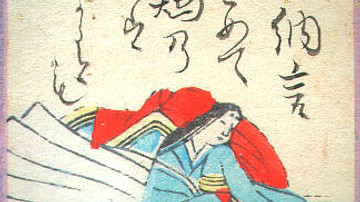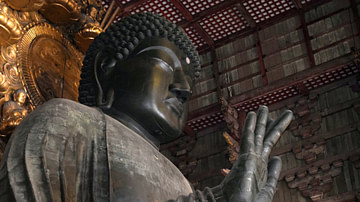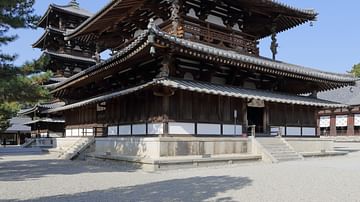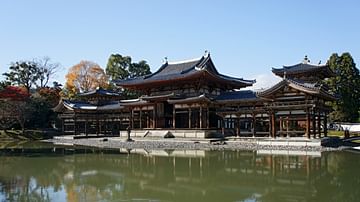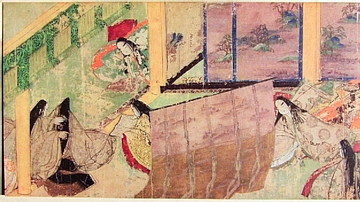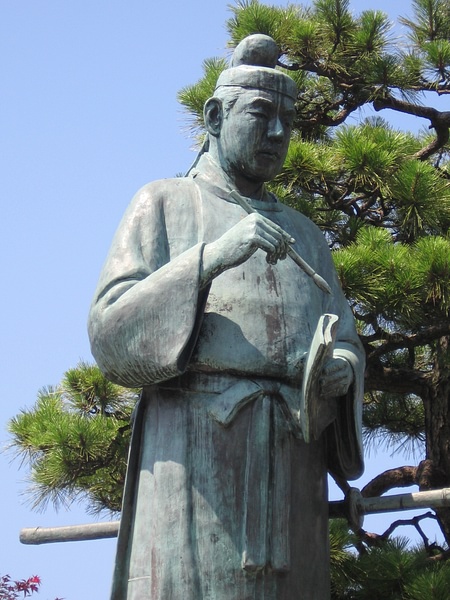
The Manyoshu or 'Collection of Ten Thousand Leaves' is an anthology of ancient Japanese poems compiled c. 759 CE during the Nara Period but including many earlier works. The most likely person to have assembled the collection is Otomo no Yakamochi, himself a prolific poet who included nearly 500 of his own works in the Manyoshu. The Manyoshu is regarded as a literary classic and high point of Japanese poetry.
Otomo no Yakamochi
Many scholars consider the Manyoshu to have been compiled by the poet Otomo no Yakamochi (c. 718-785 CE). He certainly included plenty of his own works, some 479 or 10% of the collection. Yakamochi was born into an aristocratic family and his father was also a poet. When he was 30 years old, Yakamochi was made governor of the then minor and remote province of Etchu (modern Toyama Prefecture). This posting perhaps explains the poet's penchant for themes of separation and loneliness, unrequited love and descriptions of nature.
On an evening when the spring mists
Trail over the wide sea,
And sad is the voice of the crane,
I think of my far-off home.
Otomo no Yakamochi (Henshall, 316)
Fortunately for Yakamochi, his posting was not permanent, and when he returned to the capital at Nara, he was given a role in the Ministry of Military Affairs. This did not stop his love of poetry as he was known to collect poems from the guards around the city. After 750 CE the poems stop, and Yakamochi died in 785 CE.
The Manyoshu
The Manyoshu collection contains poems which were all written in the Japanese of that time, i.e. using Chinese characters phonetically. The work consists of 4,496 poems organised into 20 books, the vast majority being in the tanka (aka waku) style, that is each poem has precisely 31 syllables in five lines (5+7+5+7+7). 262 poems, in contrast, are written in the longer nagauta style, which can have up to 200 lines. There are also 62 sedoka poems (six-line poems of 38 syllables) and four poems written in Chinese. The poems come in three broad thematic categories; zoka (miscellaneous), somon (mutual inquiries or love poems), and banka (elegies). The poems cover a period of four centuries and it is likely they were intended to be sung.
Like Yakamochi's contributions, many of the poems deal with sadness and melancholy. Other famous names in the collection include Kakinomoto Hitomaro (active 685-705 CE) and Yamanoue Okura (660 - c. 733 CE). The former was only a low-ranked official at court, but he was regarded as the finest poet of the period. He has more than 80 of his poems in the anthology. Yamanoue Okura, another government official, but this time with experience of China (he may have come to Japan as a refugee from the Korean state of Baekje), is represented by 70 poems. He was tutor to the crown prince (future Emperor Shomu), and his work is noted for its social element, notably on poverty. Other poets who contributed to the Manyoshu include less well-known poets, diplomats, princesses, emperors, soldiers, peasants, and many works are anonymous.
Example Poems
Countless are the mountains
in Yamato,
but perfect is
the heavenly hill of Kagu:
When I climb it
and survey my realm,
Over the wide plain
the smoke wreaths rise and rise,
over the wide sea
the gulls are on the wing;
a beautiful land it is,
Akitsushima,
the Land of Yamato.
Emperor Jomei (Keene, 96)
When, loosened from the winter's bonds,
The spring appears,
The birds that were silent
Come out and sing,
The flowers that were prisoned
Come out and bloom;
But the hills are so rank with trees
We cannot seek the flowers,
And the flowers are so tangled with weeds
We cannot take them in our hands.
But when on the autumn hill-side
We see the foliage,
We prize the yellow leaves,
Taking them in our hands,
We sigh over the green ones,
Leaving them on the branches;
And that is my only regret -
For me, the autumn hills!
Princess Nukata (Keene, 101)
Our great Sovereign, a goddess,
Of her sacred will
Has reared a towering palace
On Yoshino's shore,
Encircled by its rapids;
And, climbing, she surveys the land.
The overlapping mountains,
Rising like green walls,
Offer the blossoms with spring,
As godly tributes to the Throne.
The god of the Yu River, to provide the royal table.
Holds the cormorant-fishing
In its upper shallows,
And sinks the fishing-nets
In the lower stream.
Thus, the mountains and the river
Serve our Sovereign, one in will;
It is truly the reign of a divinity.
Kakinomoto Hitomaro (Keene, 103-4)
There I found you, poor man! -
Outstretched on the beach,
On this rough bed of stones,
Amid the busy voices of the waves.
If I but knew where was your home,
I would go and tell;
If your wife but knew,
She would come to tend you.
She, not knowing the way hither,
Must wait, must ever wait,
Restlessly hoping for your return -
Your dear wife - alas!
Kakinomoto Hitomaro (Keene, 111)
Will ever there be
Someone else who will rest
Her head on my arms
As once my beloved wife
Made her pillow there?
Otomo no Tobito (Keene, 133)
Keeping glum silence
In the role of a wise man
Is still not as good
As drinking one's own sake
And weeping drunken tears.
Otomo no Tobito (Keene, 137)
…And in the cauldron
A spider spins its web.
With not a grain to cook,
We moan like the “night-thrush.”
Then, “to cut”, as the saying is,
“The ends of what is already too short,”
The village headman comes,
With rod in hand, to our sleeping-place,
Growling for his dues.
Must it be so hopeless -
The way of this world?
Yamanoue Okura (Keene, 145)
If it were death to love,
I should have died -
And died again
One thousand times over.
Otomo no Yakamochi (Keene, 151)
Legacy
The poems of the Manyoshu inspired many later poets who copied the styles, imagery, and even phrases of the great masters. Some later poets wrote extensions of earlier works or their own 'replies' too. Even in structure the book has been influential, for, although it is not clear why the Manyoshu was divided into 20 books, it was a model followed by nearly all subsequent Japanese anthologies. The Manyoshu has been endlessly studied ever since its publication, not only regarding the meaning of the poems but also to create specialised studies on the biographical details, religious practices, and even the plants mentioned throughout this most important of Japanese anthologies.
This content was made possible with generous support from the Great Britain Sasakawa Foundation.

